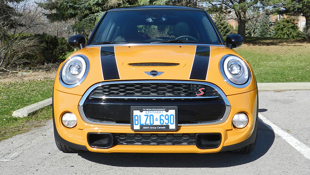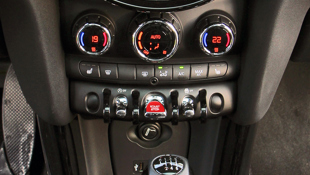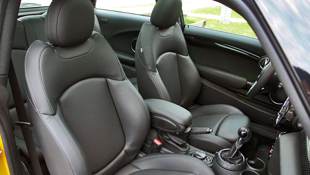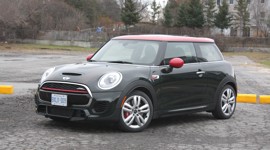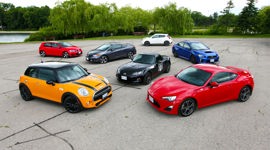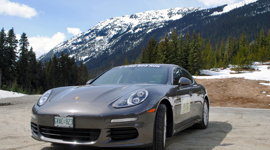“Mini, Mini, Mini, Mini – Mini Mini Mini Mini – MINIIIIII!” That’s my Mini song. It’s about the Mini and it is sung to the tune of the Batman theme. If you live in Toronto, you might have heard that being half-sung/half-cackled as I laughed my way around the city for an entire week behind the wheel of the single most fun-loving vehicle on the road.
Last year after my first drive in the 2013 Mini Cooper S Hatch I was so moved by it that I performed a happy dance. The 2014 Mini Cooper S Hatch invoked a reprisal of that dance – much to the horror delight horror [fixed that for ya’ –Ed.] of my colleagues in the office.
The Cooper S is still the raucous, frolicking, grin-inducing pocket rocket it was then, but this is not the same car – nay, nay. It has grown up. Matured, softened a little, yes but also learned some new tricks. And like most of us the Mini has picked up a little extra girth with age. This edition is 42 kg heavier at 1,252 kg. The steering is heavier and that dulls the sensation slightly, but the ride on uneven roads is dramatically better and the Mini now tracks more truly in corners. I could happily drive this for hours on end without feeling uncomfortable – something I couldn’t really achieve in the previous.
Turn-in is equally rapid but it takes more effort to get the 2014 Mini loose in the rear, this bigger, more mature version is far more composed than the old. If the old one was a puppy, this one is a puppy, post obedience training. Part of that can be attributed to the $50 performance tire option that adds 205/45R17 Hankook Ventus S1 evo2 tires. They have grip for days.
At 3,858 mm, it’s 129 mm longer than the previous model, and is also 44 mm wider at 1,727 mm. Height is up, too, 1,414 mm for the 2014 versus 1,407 in 2013. Those numbers are small, but visually make a big difference and the new Cooper S looks far larger than its predecessor. Wheelbase is 27 mm longer at 2,495 mm, and front/rear track has grown to 1,485 mm. The 8 mm difference between front and rear track on the 2013 model is gone, this one is now even.
The fuel tank is actually smaller – down to 44 L from 50. Curiously the base Cooper has an even smaller 40 L fuel tank.
The engine is bigger too. A boosted 2.0L now sits where the boosted 1.6L was before. Happily, the growth has extended to the power ratings. Power is up 8 horses to 189 hp and is produced at 4,700 rpm – 800 rpm earlier than 2013. The turbo four produces 207 lb-ft of torque at 1,250 rpm, up from 177 at 1,600 in the previous model. The increase in grunt is noticeable from launch, especially with sport mode engaged. You can get it with a six-speed automatic, but every time you do a unicorn dies – so please be responsible and order the manual. Thankfully the BMW press department are unicorn conservationists – so this one came with a third pedal. The clutch is easy to use but not as well-defined as some I’ve used, and the gearbox has an odd flaw. A few times both myself and other drivers found the lever sliding across partially into the reverse gate on hard downshifts from third to second, a quirk of Mini’s reverse-gear placement (extreme left and up) and lack of a ‘trigger’ to engage it. Once we’d stopped our fumbling, the gearbox was a joy to use, snapping home with confidence as long as the numpty at the tiller was on his game. The automatic rev-matching makes heel-and-toe downshifting unnecessary, but if you want to do it anyway the pedals are well spaced for it.
The larger engine and extra weight make the Mini a bit thirstier in the city where it achieves an EPA-rated 9.4 L/100 km instead of 9.0. But the added grunt give it the edge over the 2013 on the highway where 6.2 L/100 km improves over 6.7.
The result of the changes is that there is no change in the EPA’s combined rating of 8.1 L/100 km. I personally saw an improvement as I ended the week at 7.9 L/100 km versus 8.5 in the previous model.
But honestly, who on Earth cares? The Cooper S, while efficient, is not a fuel miser’s car. The Cooper S, while larger than the previous, is not a practical city car for hipsters. The Cooper S is not for a thinker, Ricky Bobby, the Cooper S is for a driver.
If you like fuel economy, you can slide the little button under the gear lever to the right, and the screen will put up a funky graphic that says “let’s MINImalize!”. The light-bar tachometer that surrounds the screen also glows green. Want to go faster? Well, slide the button to the left, and the tach glows red, and the Mini says “Let’s motor hard!” with a go-kart and rocket superimposed over a picture of the Mini. Some people might think that’s a goofy gimmick and has no value whatsoever. Those people aren’t much fun to speak to at dinner parties.
If you have the $2,100 Loaded Package, which comes with Dynamic Damper Control, sport mode firms up the suspension as well as improving throttle response and power delivery. The drive is noticeably stiffer and the engine raspier. Sadly, the ever-present overrun exhaust burble that delighted me so much last year has been muted in this edition. It is there if you really try hard to induce it now, but the push for better power delivery and fuel economy has resulted in less excess fuel for the exhaust pipe to play with.
The interior has at once matured, and simultaneously become more juvenile. For example, the speedo has now moved to a permanent new home behind the steering wheel. That’s more sensible and mature.
Where the quirky mid-dash speedo used to be there is now a large circular housing for the 8.8-inch infotainment screen. On the outside of that screen, a segmented light-bar is a digital tachometer. The lights climb around the edge of the circle as engine revs rise. That’s pretty cool but a bit juvenile.
The motorcycle-style instrument cluster moves up and down and in-and out with the tilt/telescopic steering column and is comprised of a light-bar fuel gauge, analogue speedometer and tachometer, plus a small TFT screen with an extremely crisp readout. That readout shows the current gear plus a suggested one if you’re not in the most efficient gear as well as the normal trip computer information.
The analog tach has two readings at zero, Ready and Off. Why? The 2014 model now has automatic engine shutoff at idle. It’s a very crisp system that turns off the engine completely imperceptibly and re-ignites it with barely a quiver. My wife adored it – as she did with every single other aspect of the Mini.
In 2013 my passengers couldn’t find the power window buttons, they were squashed into all the other toggles in the centre stack. For 2014 they move to a far more sensible location on the doors. This frees up space on the centre stack, making the toggles less crowded and more usable. The effect is a tipping of the scales from “quirky but annoying” to “quirky and fun”. My aforementioned wife said of the previous car that she could “learn to live with” the interior – this one there is no such compromise needed. Even the miniature joystick of old is gone, replaced by BMW’s large touchpad rotary dial. It’s positioning is a little cramped, but its operation is top-shelf BMW and vastly improves the user experience of the Cooper S’s infotainment system.
But none of this is the best part of Mini’s revision.
Compared to the 2013, driving the 2014 Mini is like reconnecting with a high-school crush in your 30s. She’s a little bigger, sure, but more refined, more composed, and more confident. She’s still fun, still open for experiments and still up for action, but more sure of herself and a better performer.
All this newfound refinement and maturity usually comes with more cost. But this one is cheaper than the model it replaces. Way cheaper!
My 2013 Cooper S tester’s base was $28,950, by the time I got into it the as-tested price was $39,060. Mini has slashed the base price to $25,490 for this model year, and my tester topped out at $33,365. That included a $50 performance tire upgrade and a $1,000 lighting upgrade that made me finally understand what premium lighting could do. These LED units are dazzling even in the daylight, and well worth the money.
So for almost $6,000 less all I’m missing is the $2,900 JCW package, $550 Sirius XM and $490 metallic paint (which is $590 in 2014). The 17-inch wheels, leather steering wheel, Bi-Xenon headlights, Dynamic Traction Control, leather interior from the JCW kit are all included in my tester, so that package is no longer necessary, and the revised front fascia and rear spoiler render the JCW aerokit largely obsolete.
Translation? The 2014 Mini is legitimately $5,000 cheaper than a similarly equipped 2013 model and now a genuine sub-$30K contender.
I would spend that money on plastic surgery to correct the permanent, Mini-induced grin on my face.
Competitors
Fiat 500 Abarth
Honda Civic Si
Hyundai Veloster Turbo
Mazdaspeed 3
Subaru WRX STI
VW GTI
VW Super Beetle
| Model Tested | 2014 Mini Coopers S |
|---|---|
| Base Price | $25,490 |
| A/C Tax | $100 |
| Destination Fee | $1,655 |
| Price as Tested | $33,365 |
|
Optional Equipment
Loaded Package (comfort access, dynamic damper control, rain-sensor with auto headlamps, automatic climate control, essentials package) - $2,100, LED Lights package - $1,000, Wired Navigation Package (front centre armrest, on-board navigation, integrated visual display, Bluetooth and USB audio, MINI connected wire package - $1,850, 17-inch Cosmos Spoke Black - $740, Anthracite Roofliner - $250, Black Bonnet Stripes - $130, Performance Tires - $50, Black Roof and Mirror Caps – Free.
|
|

